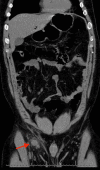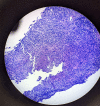Cat Scratch Disease: An Unusual Case of Right Inguinal Lymphadenitis Due to Bartonella henselae
- PMID: 37772236
- PMCID: PMC10532035
- DOI: 10.7759/cureus.44280
Cat Scratch Disease: An Unusual Case of Right Inguinal Lymphadenitis Due to Bartonella henselae
Abstract
Cat scratch disease (CSD) is caused by a bacterial infection due to Bartonella henselae and is associated with young cats and kittens. CSD commonly occurs as regional lymphadenitis in the setting of subacute regional lymphadenopathy predominantly in children and young adults. The prognosis for immunocompetent patients is favorable with complete recovery, however, immunocompromised adults can progress to life-threatening complications such as neuroretinitis, osteomyelitis, and bacillary angiomatosis. B. henselae is transmitted from cats to humans through scratching or biting when located on the cat's claws or oral cavity. In 1% of diagnosed cases, patients developed this disease without ever receiving an animal scratch. We present a case of a 29-year-old immunocompetent male developing severe right inguinal pain with concern for an incarcerated inguinal hernia. He reported exposure to a vaccinated six-month-old kitten but denied any recent scratches or bites. His infectious workup revealed right inguinal lymphadenitis on CT imaging and subsequent lymph node biopsy confirmed a diagnosis of CSD. He was treated with a short course of oral doxycycline for CSD and opioids for pain management. This case illustrates the importance of thorough complete history and physical taking even in immunocompetent patients and early recognition with prompt targeted treatment of Bartonella lymphadenitis to prevent unfavorable outcomes.
Keywords: bartonella; bartonella henselae; cat-scratch disease; inguinal lymphadenitis; inguinal lymphadenopathy.
Copyright © 2023, Sulaiman et al.
Conflict of interest statement
The authors have declared that no competing interests exist.
Figures




References
-
- Pathogenicity and treatment of Bartonella infections. Angelakis E, Raoult D. Int J Antimicrob Agents. 2014;44:16–25. - PubMed
-
- Etiology of cat scratch disease: comparison of polymerase chain reaction detection of Bartonella (formerly Rochalimaea) and Afipia felis DNA with serology and skin tests. Bergmans AM, Groothedde JW, Schellekens JF, van Embden JD, Ossewaarde JM, Schouls LM. https://doi.org/10.1093/infdis/171.4.916. J Infect Dis. 1995;171:916–923. - PubMed
-
- Lymphadenitis associated with cat-scratch disease simulating a neoplasm: imaging findings with histopathological associations. Chen Y, Fu YB, Xu XF, et al. https://doi.org/10.3892/ol.2017.7311. Oncol Lett. 2018;15:195–204. - PMC - PubMed
-
- Seronegative cat-scratch disease diagnosed by PCR detection of Bartonella henselae DNA in lymph node samples. Chondrogiannis K, Vezakis A, Derpapas M, Melemeni A, Fragulidis G. https://doi.org/10.1590/s1413-86702012000100019 . Braz J Infect Dis. 2012;16:96–99. - PubMed
-
- Cat-scratch disease: case report and review of the literature. Gai M, d'Onofrio G, di Vico MC, et al. https://doi.org/10.1016/j.transproceed.2015.07.014. Transplant Proc. 2015;47:2245–2247. - PubMed
Publication types
LinkOut - more resources
Full Text Sources
Miscellaneous
